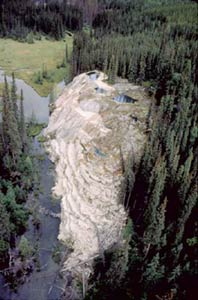Coal River Springs Territorial Park
Still relatively untouched, the springs' dramatic formations are a staircase of dripping colour. A descending series of limestone terraces, framed by lush green vegetation, embraces overflowing pools of rich, icy blue water (these are cool springs, not hot springs). These unusual and extensive formations, and the rich diversity of life forms associated with year-round flowing water, make Coal River Springs a unique and special feature of territorial and national significance. On September 17, 1990, a 16 square kilometre area encompassing the springs was officially dedicated as the Yukon's second Territorial Park and first Ecological Reserve. Coal River Springs Territorial Park was created through the combined efforts of the Yukon Government, the Liard First Nation and the Nature Conservancy of Canada. What to do there How to get there It is possible to bushwhack from a rough mining exploration/logging road to the banks of the Coal River. To do this, you must negotiate a hilly, two kilometre maze of large diameter, wind-thrown, fire-killed trees. At this point you may be blocked by the river, fordable only in the low water of late summer and, even then, potentially dangerous. Other access is by helicopter from Watson Lake. This is usually a one hour return flight. Unique Formations This precipitate, known as tufa, is deposited on the surface of any object in contact with the water. Twigs, leaves, whole trees and even animal carcasses eventually become covered in the rock-like tufa. Living mosses that rim the pools are literally turned to stone. The continual build-up of tufa, at a rate of two to three centimetres a year, has created the terraced travertine formations surrounding the springs. The edges of the springs' pools slowly grow inward and upward, so they are suspended over the layer below. If left undisturbed, the pool walls would eventually close at the top like a dome. New pools would begin to form over the old pool chambers. Several of these chambers are likely hidden below the pools we see today. Constant Change In 1984, beaver diverted the flow away from the main formations. As a result, they dried up and lost their colour. Cracks also developed and, when the flow of water returned, it took a few years before they self-sealed and refilled with water. A few parts of the main terraces remain dry today. When walking through the surrounding forest, you may observe evidence of past change. Ancient tufa can be found tangled in the roots of fallen trees. Walls of tufa from old dry pools stand like fortresses guarding secret courtyard gardens. Large, healthy trees thrive within these bastions, their roots solidly anchored. Rich Plant Life Blue grass grows here. The only other place it is found is at the mouth of the Mackenzie River over a thousand kilometres away. Wild sarsasparilla, red and white baneberry, knotweed and water-milfoil are also present around the springs. Summer brings a cavalcade of colour to this site. Bright yellow monkey-flowers nod their heads along the edge of the pools as if admiring themselves on the mirror-like surfaces. Tall purple larkspur grace the lower wetlands that drain into the Coal River. Paintbrush add splashes of salmon pink to the lower meadow. Wildlife The boreal toad and the northern wood frog are also found in these wetlands. Dolly varden inhabit the Coal River beside the springs and tiny sculpins swim in some of the terraced pools high on the bluff. Facilities Leave no trace: Guidelines for Visitors
Contact us |
Territorial Parks Contents Parks Contents Popular Topics
|
 |
|
|
Contact Us | Site Map | |
 About
About